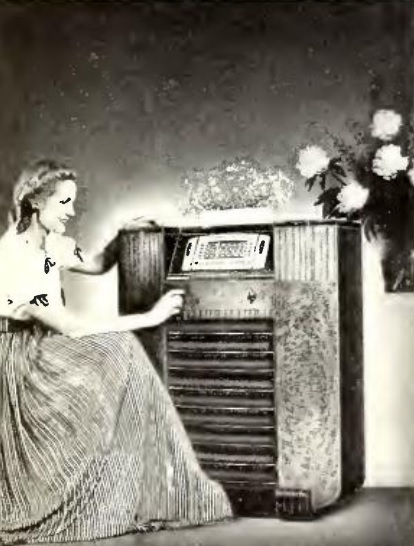Seventy-five years ago, one apparently dressed up to listen to the radio, especially if you were listening to static-free FM. As related in an earlier post, FM was just starting to gain a modest foothold prior to the war. FM then operated on 42-50 MHz. The Milwaukee station, for example, was on 42.6 MHz. After the war, the FCC moved FM broadcasting to its current home of 88-108 MHz.
To enjoy static-free FM reception, listeners had to get a new radio. At the very least, they would have to get an FM tuner which could plug in to the phono input of their current receiver. The choices were somewhat limited, but many of the major manufacturers came out with at least one FM receiver.
General Electric’s top-of-the-line offering is shown here. It is the HM-136, and is shown in an update on FM in the May 1940 issue of Radio Today.
In addition to the FM band, the 13-tube model covered the standard broadcast band and two shortwave bands, 2.4-7.5 MHz and 7.5-22 MHz. Interestingly, the set didn’t tune the entire prewar band. It tuned only 39-44 MHz, meaning that it wouldn’t be of use in areas with stations higher in the band. Fortunately, however, the existing stations were below 44 MHz, even though the larger band was allocated.
A schematic and service information for the set can be found at Antique Electronics Supply. I haven’t found links to modern photos of surviving examples.
Click Here For Today’s Ripley’s Believe It Or Not Cartoon ![]()


Hello,
Just wanted to mentiion the reason for the odd coverage of the prewar FM band.
Prior to May 20, 1940, FM was in an experimental slot of 39-44 MHz. This radio was made before that date when the FCC gave commercial FM the “Green Light” and set the allotment at 42-50 MHz.
Reference: Radio Retailing, June 1940, Page 75 “On The Newsfront”, “Wideband F-M Gets FCC OK”
https://www.americanradiohistory.com/Archive-Radio-Retailing/40s/Radio-Retailing-1940-06.pdf
Rest Regards
-Steve